Category: Series of Related Transactions
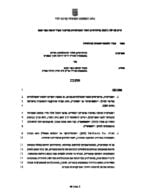
Israel vs Medtronic Ventor Technologies Ltd, June 2023, District Court, Case No 31671-09-18
In 2008 and 2009 the Medtronic group acquired the entire share capital of the Israeli company, Ventor Technologies Ltd, for a sum of $325 million. Subsequent to the acquisition various inter-company agreements were entered into between Ventor Technologies Ltd and Medtronics, but no transfer of intangible assets was recognised by the Group for tax purposes. The tax authorities found that all the intangibles previously owned by Ventor had been transferred to Medtronic and issued an assessment of additional taxable profits. An appeal was filed by Medtronic Ventor Technologies Ltd. Judgement of the District Court The court dismissed the appeal and upheld the assessment issued by the tax authorities. Click here for English translation
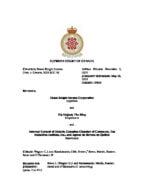
Canada vs Deans Knight Income Corporation, May 2023, Supreme Court, Case No. 2023 SCC 16
In 2007, Forbes Medi-Tech Inc. (now Deans Knight Income Corporation) was a British Columbia-based drug research and nutritional food additive business in financial difficulty. It had accumulated approximately $90 million of unclaimed non-capital losses and other tax credits. Non-capital losses are financial losses resulting from carrying on a business that spends more than it makes in a given year. Under the Income Tax Act (the Act), a taxpayer can reduce their income tax by deducting non-capital losses from its taxable income. If the taxpayer does not use all, or a portion, of the loss in the year it incurred it, they may carry the loss back three years, or forward 20 years. However, under section 111(5) of the Act, when another entity acquires control of the company, the new owners may not carry over those non-capital losses and deduct them from its future taxes, unless the company continues to operate the same or a similar business. Deans Knight wanted to use its non-capital losses but did not have sufficient income against which to offset them. In early 2008, it entered into a complex investment agreement with venture capital firm Matco Capital Ltd, to help it become profitable. The agreement was drafted in a way that ensured Matco did not acquire control of Deans Knight by becoming the majority shareholder because that would trigger the restriction on carrying over losses under section 111(5) of the Act. However, in effect, Matco gained considerable influence over Deans Knight’s business affairs. It found a separate mutual fund management company that would use Deans Knight as a corporate vehicle to raise money through an initial public offering. That money would then be used to transform Deans Knight into an investment business. This was attractive to Deans Knight because it could make use of its non-capital losses to shelter most of the new business’ portfolio income and capital gains. When Deans Knight filed its tax returns for 2009 to 2012, it claimed nearly $65 million in non-capital losses and other tax credits, thereby reducing its tax liability. The tax authorities reassessed Deans Knight’s tax returns and denied the deductions. The company appealed that decision to the Tax Court of Canada. The Tax Court found that Deans Knight gained a tax benefit through a series of transactions that it concluded primarily for tax avoidance purposes, but that the transactions did not amount to an abuse of the Act, namely section 111(5). The tax authorities appealed to the Federal Court of Appeal, which held that the transactions were abusive. It applied the “general anti-avoidance rule” (GAAR) under the Act to deny Deans Knight’s tax deductions. The GAAR operates to deny tax benefits flowing from transactions that comply with the literal text of the Act, but that nevertheless constitute abusive tax avoidance. Deans Knight appealed to the Supreme Court. Judgement of the Supreme Court The Court dismissed the appeal of Deans Knight and upheld the decision from the Court of Appeal. It found the transactions were abusive and the GAAR applied to deny the tax benefits. Despite complying with the literal text of a provision in the Act, a transaction is abusive if it frustrates its rationale. The rationale behind section 111(5) of the Act is to prevent corporations from being acquired by unrelated parties in order to deduct their unused losses against income from another business for the benefit of new shareholders. Deans Knight was fundamentally transformed through a series of transactions that achieved the outcome that the Act sought to prevent, while narrowly circumventing the restriction in section 111(5). Excerpt “the appellant was gutted of any vestiges from its prior corporate ‘life’ and became an empty vessel with [unused deductions]”.
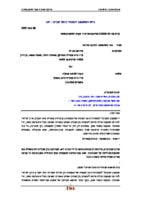
Israel vs Medingo Ltd, May 2022, District Court, Case No 53528-01-16
In April 2010 Roche pharmaceutical group acquired the entire share capital of the Israeli company, Medingo Ltd, for USD 160 million. About six months after the acquisition, Medingo was entered into 3 inter-group service agreements: a R&D services agreement, pursuant to which Medingo was to provide R&D services in exchange for cost + 5%. All developments under the agreement would be owned by Roche. a services agreement according to which Medingo was to provided marketing, administration, consultation and support services in exchange for cost + 5%. a manufacturing agreement, under which Medingo was to provide manufacturing and packaging services in exchange for cost + 5. A license agreement was also entered, according to which Roche could now manufacture, use, sell, exploit, continue development and sublicense to related parties the Medingo IP in exchange for 2% of the relevant net revenues. Finally, in 2013, Medingo’s operation in Israel was terminated and its IP sold to Roche for approximately USD 45 million. The tax authorities viewed the transactions as steps in a single arrangement, which – from the outset – had the purpose of transferring all the activities of Medingo to Roche. On that basis an assessment was issued according to which the intangibles had been transferred to Roche in 2010. Based on the acquisition price for the shares, the value was determined to approximately USD 160 millions. An appeal was filed by Medingo claiming that there had been no transfer in 2010. Judgement of the District Court The court decided in favor of Medingo and set aside the 2010 tax assessment – but without passing an opinion in relation to the value of the sale of the intellectual property in 2013. Excerpts “96. The guidelines indicate that in a transaction between related parties, two different issues must be examined using the arm’s length principle: transaction characterization and transaction pricing. The characterization of the transaction must first be examined and it must be examined whether it would also have been made between unrelated parties. If the examination reveals that even unrelated parties would have entered into a transaction in the same situation, then it must be further examined whether the price paid for the assets complies with market conditions. It should be noted that in accordance with the guidelines, the characterization of the transaction should not be interfered with in violation of the agreements, except in exceptional circumstances, in which the agreements are fundamentally unfounded, or in no way allow a price to be determined according to the arm’s length principle. “Tax A tax administration should not disregard part or all of the restructuring or substitute other transactions for it unless the exceptional circumstances described in paragraph 1.142 are met”. out circumstances in which the transaction between the parties as accurately delineated can be disregarded for transfer pricing purposes. Because non-recognition can be contentious and a source of double taxation, every effort should be made to determine the actual nature of the transaction and apply arm’s length pricing to the accurately delineated transaction, and to ensure that non-recognition is not used simply because determining an arm’s length price is difficult. e same transaction can be seen between independent parties in comparable circumstances… non-recognition would not apply… the transaction as accurately delineated may be disregarded, and if appropriate, replaced by an alternative transaction, where the arrangements made in relation to the transaction, viewed in their totality, differ from those which would have been adopted by independent enterprises behaving in a commercially rational manner in comparable circumstances, thereby preventing determination of a price that would be acceptable to both of the parties taking into account their respective perspective and the options realistically available to each of them at the time of entering into the transaction “. 97. Further to this, sections 1.146 – 1.148 of the Guideline, 2022, provide two examples of cases in which the characterization of the transaction must be ignored. The second example deals with a case closer to our case, where a one-time payment is paid for R&D services and their products provided – for 20 years. 98. After examining the characterization of the transaction in our case, I found no defect in it. This is a completely different case from those mentioned in the guidelines, and it has been proven to me that transactions with a similar characterization can be conducted and are also conducted between unrelated parties. Thus, throughout the proceedings, the appellant presented various examples of similar license agreements and R&D agreements signed between unrelated parties: In Phase A, the appellant presented various transactions for comparison (P / 2 (to which the respondent did not even refer), p. 332 of the minutes (and within the appeal Of EY Germany and of Gonen in which additional transactions were presented for comparison, including transactions of similar companies in the relevant market.” “104. I also believe that it makes sense to enter into such agreements, especially in the situation of the appellant at that time. Appellant faced considerable obstacles, and her chances of success were not guaranteed, to say the least….” “105. The inter-group agreements secured the appellant’s future in the near term, and gave her more chances to survive. As the appellant’s experts clarified, small companies find it difficult to survive alone in the medical device market (see for example Section 1 of the Michlin Opinion (hence, a licensing and commercialization agreement is common practice in the field and common with contractors with experience and resources); See also paragraph 41 regarding Broadcom).” “110. In conclusion, as long as the appellant and Roche acted in accordance with the inter-group agreements, which are acceptable in industry and in the circumstances of the case there is logic in concluding them, I did not find any invalidity in the characterization of the agreements (see paragraphs 85 and 87 in the Broadcom case).” “….As stated, I believe that even if there was an intention to transfer the activity, there was no final decision until the date of the announcement. Second, and this is the
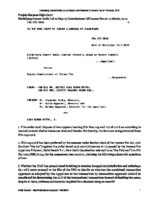
India vs Heidelberg Cement India Ltd, March 2019, High Court, Case No ITA-125-2018
Heidelberg Cement India Ltd is engaged in the business of manufacturing of cement and sells them to its customers in India. A TNM method where all the transactions was combined had been used by the company for determining the arm’s length price of its controlled transactions as they were considered closely linked. Following an audit for FY 2010 2011, the Indian tax authorities issued an assessment of additional taxable income where the pricing of the transactions had instead been determined on a transaction by transaction basis. According to the tax authorities, technical know-how fees paid to the parent company were excessive. At issue before the High Court was whether the combined transaction approach as applied by the company or the transaction by transaction approach as applied by the tax authorities was the most appropriate method for determining the arm’s length pricing of the international transactions. Judgement of the High Court The court decided predominantly in favour of the tax authorities. Excerpt: “Under Section 92(1) of the Act, any income arising from ‘an international transaction’ was required to be computed having regard to arm’s length price. More than one transaction can be taken together for determination of arm’s length price only if they were closely linked. Aggregation of transaction or combined transaction approach is accepted practice for determination of arm’s length price, however, such aggregation of transaction can be allowed if they were linked with each other. As per the transfer pricing study report, the only statement made by the assessee is that the assessee is engaged in the business of manufacturing the cement which is its primary business activity and therefore, all the transactions relating to cement manufacturing activity should be bundled together for determination of their ALP applying TNMM as the most appropriate method. The services rendered by the AE are specifically mentioned in the agreement. Therefore, there is no reason that such services cannot be evaluated independently on standalone basis.” “The Tribunal also observed that it was the duty of the assessee to show with cogent evidence and factual analysis backed by economic reasoning and business that all the international transactions were originating from one source or they were independent or were part of package deal. Further, the TPO had not recorded any finding while 5 of 6 rejecting the claim of aggregating the transaction of the assessee. Accordingly, the Tribunal had rightly remanded the matter to the file of the TPO with a direction to the assessee to justify how international transactions were closely linked.” Click here for translation
Canada vs Bank of Montreal, September 2018, Tax Court of Canada, Case No 2018 TCC 187
The Court found that section 245 (GAAR) of the Canadian Income Tax Act did not apply to the transactions in question. Subsection 245(1) defines a “tax benefit” as a reduction, avoidance or deferral of tax. The Respondent says that the tax benefit BMO received was the reduction in its tax payable as a result of subsection 112(3.1) not applying to reduce its share of the capital loss on the disposition of the common shares of NSULC. In 2005, the Bank of Montreal (“BMO”) wanted to lend a total of $1.4 billion USD to a number of its US subsidiaries referred to as the Harris Group. BMO chose to borrow those funds from third parties. Tower Structure It would not have been tax efficient for BMO to simply borrow the funds and lend them to the Harris Group. Such a structure would have resulted in BMO having to pay US withholding tax on the interest payments it received from the Harris Group. As a result, BMO implemented what is commonly referred to as a “tower structure”. A tower structure is a complicated structure often used by Canadian companies to finance US subsidiaries in a tax efficient manner. It allows the deduction of interest costs by the Canadian company for Canadian tax purposes and the deduction of the corresponding interest costs by the US subsidiary for US tax purposes without having to pay withholding tax to the US on the repatriation of the funds. The tower structure implemented by BMO consisted of the following entities: (a) a Nevada limited partnership named BMO Funding L.P. (“Funding LP”) in which BMO had a 99.9% interest and a wholly owned subsidiary of BMO named BMO G.P. Inc. (“BMO GP”) had a 0.1% interest; (b) a Nova Scotia unlimited liability company named BMO (NS) Investment Company (“NSULC”) that was wholly owned by Funding LP; and (c) a Delaware limited liability company named BMO (US) Funding LLC (“LLC”) that was wholly owned by NSULC. BMO borrowed $150 million USD from a third party. It invested those funds in Funding LP. Funding LP, in turn, used those funds to acquire shares of NSULC which, in turn, used those funds to acquire shares in LLC. LLC then took the funds that it had received and lent them to the Harris Group. The balance of the required $1.4 billion USD came from a $1.25 billion USD loan obtained by Funding LP from a third party. Again, Funding LP used those funds to acquire shares of NSULC which, in turn, used those funds to acquire shares in LLC. LLC then took the funds that it had received and lent them to the Harris Group. Interest payments and dividends flowed through the tower structure at the end of each fiscal quarter. The Harris Group would pay interest to LLC. LLC would then use the money to pay dividends to NSULC. NSULC would pay corresponding dividends to Funding LP. Funding LP would use the funds it received to pay interest on the $1.25 billion USD that it had borrowed and would distribute the balance to BMO and BMO GP. BMO would, in turn, use the funds it received from Funding LP to pay interest on the $150 million USD that it had borrowed. The dividends received by BMO from NSULC (indirectly through Funding LP) were taxable dividends. BMO benefited from a subsection 112(1) deduction in respect of those dividends. From a business point of view, by borrowing US dollars to make an investment in a US asset, BMO effectively hedged its foreign exchange risk. If the Canadian dollar decreased in value against the US dollar between 2005 and 2010, then the increase in value (in Canadian dollars) of BMO’s indirect US dollar investment in the Harris Group would be matched by the increased cost (in Canadian dollars) of repaying the $1.4 billion USD in borrowed funds. Conversely, if the Canadian dollar increased in value against the US dollar between 2005 and 2010, then the decrease in value (in Canadian dollars) of BMO’s indirect US dollar investment in the Harris Group would be matched by the decreased cost (in Canadian dollars) of repaying the $1.4 billion USD in borrowed funds. However, from a tax point of view, BMO faced a potential problem with hedging its foreign exchange risk. There would not be any problem if the Canadian dollar decreased in value. Any increase in the value of the NSULC shares held by Funding LP that arose from a decrease in the value of the Canadian dollar would be taxable as a capital gain. That capital gain would be offset by the corresponding capital loss that would arise on the repayment of the $1.4 billion USD in borrowed funds. On the other hand, BMO would have a problem if the Canadian dollar increased in value. The resulting decrease in the value of the NSULC shares held by Funding LP would give rise to a capital loss. However, the stop-loss rule in subsection 112(3.1) would reduce that capital loss by an amount equal to the value of any non-taxable dividends that Funding LP had received from NSULC. As a result, the reduced capital loss would not be sufficient to fully offset the capital gain that would arise on the repayment of the $1.4 billion USD in borrowed funds. To avoid this potential mismatch of the capital gain and capital loss, BMO implemented a modification to the tower structure. Subsection 112(3.1) applies separately to each class of shares. Therefore, BMO decided to create a structure whereby NSULC had two classes of shares. When the first set of quarterly dividends was being paid, instead of paying a cash dividend, NSULC paid a stock dividend consisting of preferred shares. This resulted in Funding LP holding two classes of shares of NSULC: common shares with a high cost base and preferred shares with a low cost base. From that point forward, all quarterly dividends were paid on the preferred shares. By isolating the dividends in this manner, BMO ensured that,

Norway vs. ConocoPhillips, October 2016, Supreme Court HR-2016-988-A, Case No. 2015/1044)
A tax assessments based on anti-avoidance doctrine “gjennomskjæring” were set aside. The case dealt with the benefits of a multi-currency cash pool arrangement. The court held that the decisive question was whether the allocation of the benefits was done at arm’s length. The court dismissed the argument that the benefits should accure to the parent company as only common control between the parties which should be disregarded. The other circumstances regarding the actual transaction should be recognized when pricing the transaction. In order to achieve an arm’s length price, the comparison must take into account all characteristics of the controlled transaction except the parties’ association with each other. While the case was before the Supreme Court, the Oil Tax Board made a new amendment decision, which also included a tax assessment for 2002. This amendment, which was based on the same anti-avoidance considerations, was on its own to the company’s advantage. Following the Supreme Court judgment, a new amended decision was made in 2009, which reversed the anti-avoidance decision for all three years. The Supreme Court concluded that in 2009 the tax authorities could also change the tax assessment for 2002, even though this tax assessment was not considered by the Supreme Court in 2008. The Court pointed out that the need for amendments pursuant to section 9-5 no. 2, litra a) of the Tax Assessment Act extends beyond the limits for the substantive legal force, cf, section 9-6 no. 5, litra e) of the Tax Assessment Act, and stated that if the tax authorities have solved a classification or allocation issue for a transaction in the same way for several income years, and there is a final and enforceable judgment for one of the years, the provision gives the tax authorities the right and obligation to also consider the tax assessments for the other years. In the specific case, the amendment for 2002 followed from the Supreme Court’s judgment for the two preceding income years, and the tax authorities then had the authority to consider the tax assessment for this year. Click here for translation
Malaysia vs Syarikat Ibraco-Peremba, May 2014, Court of Appeal, Case No. W-01-177-04/2013
Syarikat Ibraco-Peremba was a property development company in Malaysia. The company had entered into a series of elaborate transactions to avoid paying income tax on the profits made from the sale of a developed land. Profits arising from the companies sale of developed land would be treated as business income and subject to income tax. The company first incorporated a subsidiary and then, after selling the lands to the subsidiary, entered into a contract with it to develop the lands. Upon completion of the project, the company sold its shares in the subsidiary to a related company and the subsidiary company subsequently sold the developed lands to third parties. The subsidiary and related companies were then closed. The Court of Appeal held that the taxpayer had made the arrangement for the primary purpose of minimizing tax. Although Section 140 did not explicitly state that the tax administration has the power to disregard a series of transactions, as opposed to a single transaction, each individual step or transaction in an arrangement could be looked at as a whole.
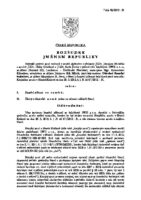
Czech Republic vs. EWE s.r.o., June 2013, Supreme Administrative Court , Case No 7 Afs 48/2013 – 31
EWE s.r.o first criticised the Regional Court for the lack of logical reasoning in the grounds of the judgment, based on evidence that it had established a legal relationship with another person mainly for the purpose of reducing the tax base. Although the facts adduced by the administrative court show that ‘some third parties’ created a relationship between them for that purpose, it does not indicate which evidence shows that it was she who created such a relationship for the purpose of reducing the tax base, as is intended by section 23(7)(b)(5) of the Income Tax Act. This defect in the court’s decision is all the more serious since she herself argued that no evidence was adduced in the administrative proceedings (in the tax inspection report) to show that she was knowingly involved in a chain of otherwise connected persons. It is thus merely the unproven assumptions of the tax authorities. No such evidence was presented by the Police of the Czech Republic in its complaint to the tax administrator. In so far as the Regional Court subsequently found such findings to be correct, its judgment is based on insufficient or incorrect findings of fact. If the administrative court accepted the conclusions of the administrative authorities that the conditions for the application of Section 23(7) of the Income Tax Act were met, it was obliged to state on what evidence it agreed with the conclusion of the Tax Directorate. However, the Regional Court failed to do so and its judgment is therefore unreviewable. This is also because no such evidence exists and was not adduced by the tax administrator, the Tax Directorate or the Regional Court. As far as it is aware, in other cases – for example, in the case of the appeal of STECOMTRA s.r.o., Tax Registration No:26847469 (another end customer of the chain in question), the Tax Directorate in Ostrava stated in its decision on the appeal that the tax administrator had failed to collect such evidence to show that the appellant knew or could have known that it was part of the chain (while it had the same documents from the police as the administrative authorities in its case). Since in her case it was not established that she was a person otherwise connected within the meaning of section 23(7) of the Income Tax Act, there was no legal reason for the tax authorities to ask her to prove the difference between her purchase price and the normal price. She was, therefore, not required to satisfactorily prove the alleged price difference. The tax authorities were therefore not legally entitled to adjust the tax base by the difference found. Any determination of the normal price was therefore irrelevant. The taxpayer’s normal price was the price at which it purchased the services from its supplier (Property). That company also offered its services to others at the prices paid to it. The price invoiced in her case was also the price for similar advertising in other media. The Regional Court therefore not only misinterpreted Section 23(7) of the Income Tax Act, but also incorrectly considered her burden of proof. If there were no material doubts on the part of the tax authority, there was no obligation on the tax authority to prove the differences between the prices. It cannot therefore be concluded that, as a taxable person, it did not satisfactorily document and prove the difference in prices between the services it purchased and similar services contracted between unrelated parties. The Regional Court thus erred in its consideration of the issue of the taxpayer’s burden of proof (Article 92(5)(d) of the Tax Code). Since the Regional Court, without giving any further reasons, merely followed the legal opinion of the Tax Directorate, thereby approving, inter alia, the unlawful procedure of the administrative authorities, its judgment is also unreviewable. By that defective procedure, the administrative court also infringed the applicant’s right to seek protection of her rights before an independent and impartial tribunal. In its written observations on the appeal, the Directorate of Appeal considers that the extraordinary appeal is unfounded. The judgment of the Regional Court is factually correct and not unreviewable. The objection that the Regional Court, like the administrative authorities, does not indicate which evidence shows that the appellant established a legal relationship with another person mainly for the purpose of reducing the tax base is entirely unfounded. Both the Regional Court and the administrative authorities have dealt with the question of otherwise connected persons and have duly established that fact. The complainant was at the end of the chain when it purchased advertising at 22 times the price charged by the first link in the chain, which provided the service at the normal price. Both the existence of this chain and the amounts invoiced in this chain were proven. The administrative authorities have thus met their burden of proof under Article 23(7) of the Income Tax Act and have established the objective situation, namely that the complainant was part of a chain of otherwise connected persons. The applicant therefore requests the Supreme Administrative Court to dismiss the appeal. Judgement of the Court The Court dismissed the appeal of EWE s.r.o. Excerpt “The Supreme Administrative Court notes that a person under section 23(7)(b)(5) of the Income Tax Act is any person who benefits from the actions of persons in a chain whose effect and purpose is predominantly to reduce the tax base or increase the tax loss (here, a 22-fold increase in the tax-effective expenditure). This does not change the complainant’s assumption that the Tax Directorate is obliged to prove the subjective aspect of such unfair conduct, i.e. her knowledge of such conduct (intent), i.e. that she entered into the contractual relationship with knowledge of a possible reduction in her tax base. The question of fault is relevant in criminal law, but not in the tax administration proceedings (tax law). Moreover, the fact that a possible expense originated with persons who are otherwise related does not in itself
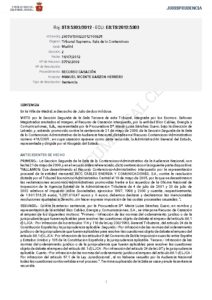
Spain vs. Bicc Cables Energía Comunicaciones S.A., July 2012, Supreme Court, Case No. 3779/2009
In May 1997, BICC CABLES ENERGÍA COMUNICACIONES, S.A. acquired 177 class B shares in BICC USA Inc. (BUSA) for USD 175 million. The par value of each share was one dollar. The acquisition price of the shares was set on the basis of an Arthur Andersen Report which stated that the fair market value of BUSA was USD 423 million. BUSA was the holding company of four investee companies, so the valuation was made in relation to each of the groups of investee companies. The shares acquired by BICC CABLES were Class B shares, with a fixed annual dividend of 4.5% of the total investment. This dividend was paid, at BUSA’s discretion and in accordance with the agreements entered into between the parties, either in cash or by delivery of shares in the Class B company. The acquisition was financed by (1) Ptas. 3,450,000,000,000 charged to the unrestricted reserves account of BICC CABLES and (2) 22,000,000,000 pesetas through a loan granted by an English bank at an interest rate of 6.03%. As a result of the acquisition, BICC CABLES received a shareholding percentage of 15%, which was much lower than what would correspond to the cost of the shares (175 million US dollars) in relation to the value estimated by the auditing company (423 million US dollars). In 1998, BUSA delivered 32 Class A shares to BICC CABLES as a dividend, valued at 1,321,546,634 pesetas. In 1999, no dividend was paid to the company. In June 1999, BICC CABLES repaid part of the loan early (Ptas. 3,600,000,000). Furthermore, in November 1999, BICC OVERSEAS INVESTMENTS Ltd. (BOIL) acquired the BUSA shares owned by BICC CABLES and, at the same time, subrogates itself to the part of the loan which had not been repaid. The shareholding structure of BICC CABLES was as follows: (1) BICC OVERSEAS INVESTMENTS Ltd. (BOIL), a <>, holds 615,000 shares (43.69% of the capital), 2) BICC CEAT CAVI SRL (BICC Plc.), the parent company of the group, holds 226,451 shares (19.05%), and (3) BANCO SANTANDER holds 500,000 non-voting shares (35.5%). In February 2000 SANTANDER sold its shares to BICC Plc. In 1997, BICC CABLES considered Ptas. 899,129,800 as tax deductible financial expenses arising from the loan. In 1998, the expenses linked to the loan Ptas. 1,326,600,000 were deducted from the taxable income. Dividend received this year (the 32 BUSA class A shares valued at Ptas. 1,321,546,634), was not included in the profit and loss account. The company claimed that income corresponding to the dividend would be accounted for when the shares were sold. In 1999, financial expenses related to the loan Ptas. 489,099,461 were considered deductible. In 2000, the partial repayment of the loan and the loss on the transfer of the shares to BOIL were accounted for, despite the fact that they corresponded to two transactions carried out in 1999″. On this bagground a tax assessment was issued by the tax authorities, in which the tax effects (deductions and losses) of the above transactions were disregarded. This assessment was appealed to the Court by BICC. The court of first instance dismissed the appeal and decided in favour of the tax authorities. Judgement of the Supreme Court The Supreme Court likewise found that the transaction would not have been agreed by independent parties and thus not had been in accordance with the arm’s length principle. Excerpts from the case “The application to the case of the provision in question does not appear to be conditional, contrary to what is claimed in the application, on the classification of the transaction in question as <> or <>. If the absence of free will on the part of the taxpayer is established, if it can be stated that the activity in question was exclusively determined by the link between the companies and if it is clearly inferred – from the evidence – that the same transaction would not have been carried out by independent companies, the competent tax authorities may make the appropriate adjustments, including, in this case, the annulment of any tax effect that might derive from the transaction in question.” “it can be concluded, in agreement with the contested decisions, that the transaction resulted in BICC USA Inc. (BUSA) obtained substantial financial resources without the incorporation of shareholders from outside the group; furthermore, it gave rise to costs for the Spanish entity, which obtained no advantage or profit whatsoever, but only losses. It can easily be concluded that the operation was decided and imposed by the group’s parent company in order to increase the resources of its American subsidiary and that, in any event, in view of the above data, such an operation would not have been carried out by an independent company.” “In any case, it is clear that the Administration has made use of the anti-avoidance rules contained in article nine of the Double Taxation Convention, which constitutes our domestic law.” Click here for English translation Click here for other translation
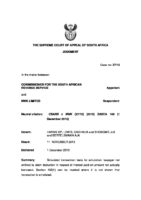
South Africa vs. NWK LtD, Dec. 2010, Supreme Court of Appeal, Case No. 27/10
Over a period of five years, from 1999 to 2003, the respondent, NWK Ltd, claimed deductions from income tax in respect of interest paid on a loan to it by Slab Trading Company (Pty) Ltd (Slab), a subsidiary of First National Bank (FNB), in the sum of R 96.415.776. The deductions were allowed. But in 2003 the appellant, the Commissioner for the South African Revenue Service, issued new assessments disallowing the deductions and refusing to remit any part of the interest on the amounts assessed. He also imposed additional tax and interest in terms of ss 76 and 89quat of the Income Tax Act 58 of 1962. The amount claimed pursuant to the additional assessments, including additional tax, was R 47.360.583. The basis of the revised assessments by the Commissioner was that the loan was not a genuine contract: it was part of a series of transactions entered into between NWK and FNB and its subsidiaries, all designed to disguise the true nature of the transaction between NWK and FNB, with the intention of NWK avoiding or reducing its liability for tax. NWK appealed against the assessments and the imposition of additional interest and penalties. Boruchowitz J and two assessors in the Tax Court held at Johannesburg upheld the appeal. It is against the order of the Tax Court that the Commissioner appeals. The basis of the Commissioner‟s argument on appeal is that the loan was simulated: that it had to be viewed in the light of several other agreements concluded between NWK and FNB, and FNB and its subsidiaries, which together showed that a sum of only R50m was lent by FNB to NWK, and that the transactions were devised to increase the ostensible amount lent so that deductions of interest on a greater amount could be claimed. NWK argued, on the other hand, that there was an honest intention on the part of NWK, represented by Mr E Barnard, its financial director, to execute the contracts in accordance with their tenor, and the claims for deductions were valid. The Tax Court accepted this contention and upheld the appeal to the Tax Court on this basis. The Supreme Court of Appeal ruled in favor of the Revenue Service (a) The objection to the assessments is dismissed and the additional assessments are upheld. (b) The objection to the imposition of additional tax of 200 per cent is upheld. (c) Additional tax of 100 per cent of the total amount of the additional assessments is imposed in terms of s 76 of the Income Tax Act 58 of 1962.
